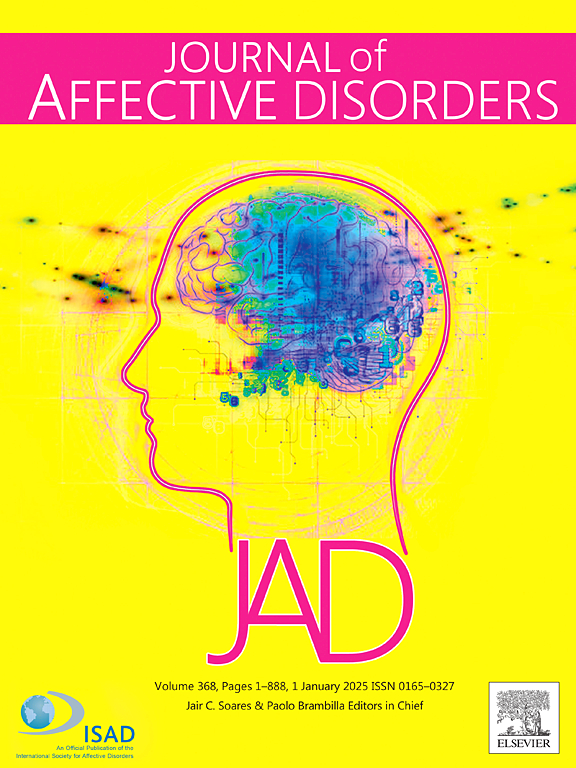Inflammatory biomarkers as predictors for unlocking antidepressant efficacy: Assessing predictive value and risk stratification in major depressive disorder in a prospective longitudinal study
IF 4.9
2区 医学
Q1 CLINICAL NEUROLOGY
引用次数: 0
Abstract
Background
Major depressive disorder (MDD) is characterized by significant heterogeneity in treatment response, with inflammation hypothesized to play a role in its pathophysiology. Peripheral inflammatory biomarkers, such as the neutrophil-to-lymphocyte ratio (NLR) and C-reactive protein (CRP), may predict antidepressant efficacy. This study investigated the association between baseline inflammatory biomarkers, their changes, and antidepressant treatment outcomes in patients with MDD.
Methods
A prospective longitudinal cohort study in Qatar recruited 123 MDD outpatients (aged 18–64). Baseline assessments included NLR, CRP, monocyte-to-lymphocyte ratio (MLR), and platelet-to-lymphocyte ratio (PLR). Depression severity was measured via the Zung Self-Rating Depression Scale (ZSRS) at baseline and 12 weeks post-treatment. Statistical analyses, including multiple regression and Random Forest machine learning models, identified predictors of antidepressant response.
Results
Improvement in depressive symptoms was associated with female sex, higher mean corpuscular volume (MCV), lower absolute neutrophil count (ANC), and higher eosinophil counts. However, changes in NLR, MLR, PLR, and CRP did not predict treatment response. Folate levels and PLR were identified by the machine learning model as top predictors, suggesting potential utility as biomarkers for response classification. Our study identified predictors of improvement in suicidal ideation, including hematological markers (lower RBC, higher eosinophils, lower monocytes), younger age, female sex, medical comorbidities, and longer assessment intervals.
Conclusion
Baseline ANC and eosinophil count may help stratify MDD treatment outcomes, though post-treatment biomarker changes were not linked to symptom improvement. Our findings highlight suicidality as a distinct pathology within depression, necessitating tailored interventions. This study highlights the complexity of inflammation in depression and suicidality, emphasizing the need for advanced biomarkers utilization in precision medicine and personalized psychiatry treatment.
炎症生物标志物作为释放抗抑郁疗效的预测因子:在一项前瞻性纵向研究中评估重度抑郁症的预测价值和风险分层
重度抑郁症(MDD)的特点是治疗反应具有显著的异质性,炎症被认为在其病理生理中起作用。外周炎症生物标志物,如中性粒细胞与淋巴细胞比率(NLR)和c反应蛋白(CRP),可以预测抗抑郁药的疗效。本研究调查了基线炎症生物标志物及其变化与重度抑郁症患者抗抑郁治疗结果之间的关系。方法卡塔尔的一项前瞻性纵向队列研究招募了123例MDD门诊患者(18-64岁)。基线评估包括NLR、CRP、单核细胞与淋巴细胞比值(MLR)和血小板与淋巴细胞比值(PLR)。在基线和治疗后12周通过Zung抑郁自评量表(ZSRS)测量抑郁严重程度。统计分析,包括多元回归和随机森林机器学习模型,确定了抗抑郁反应的预测因子。结果抑郁症状的改善与女性、较高的平均红细胞体积(MCV)、较低的绝对中性粒细胞计数(ANC)和较高的嗜酸性粒细胞计数有关。然而,NLR、MLR、PLR和CRP的变化并不能预测治疗反应。机器学习模型将叶酸水平和PLR确定为最重要的预测因子,这表明作为反应分类的生物标志物具有潜在的实用性。我们的研究确定了自杀意念改善的预测因素,包括血液学指标(红细胞减少、嗜酸性粒细胞增加、单核细胞减少)、年龄更小、女性、医学合并症和更长的评估间隔。结论基线ANC和嗜酸性粒细胞计数可能有助于MDD治疗结果的分层,尽管治疗后生物标志物的变化与症状改善无关。我们的研究结果强调了自杀是抑郁症中一种独特的病理,需要量身定制的干预措施。这项研究强调了炎症在抑郁症和自杀行为中的复杂性,强调了在精准医学和个性化精神病学治疗中利用先进生物标志物的必要性。
本文章由计算机程序翻译,如有差异,请以英文原文为准。
求助全文
约1分钟内获得全文
求助全文
来源期刊

Journal of affective disorders
医学-精神病学
CiteScore
10.90
自引率
6.10%
发文量
1319
审稿时长
9.3 weeks
期刊介绍:
The Journal of Affective Disorders publishes papers concerned with affective disorders in the widest sense: depression, mania, mood spectrum, emotions and personality, anxiety and stress. It is interdisciplinary and aims to bring together different approaches for a diverse readership. Top quality papers will be accepted dealing with any aspect of affective disorders, including neuroimaging, cognitive neurosciences, genetics, molecular biology, experimental and clinical neurosciences, pharmacology, neuroimmunoendocrinology, intervention and treatment trials.
 求助内容:
求助内容: 应助结果提醒方式:
应助结果提醒方式:


